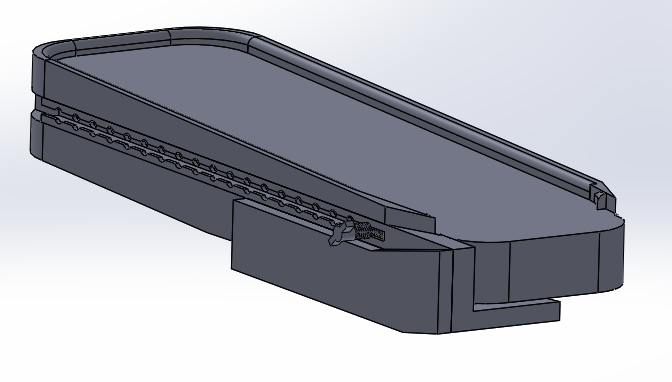Final Design
Purpose
The ultimate purpose of this design was to provide a protetive, durable, and removable covering that
aids in the mitigation of running shoe spike damange.
Major Decisions
Over the course of this project, the most significant major decisions originated from singling out ideas
based on evaluation criteria. Ultimately, the most important evaluation criteria was whether the idea would
provide the best spike protection. Other significant decisions were based on repairability,
energy absorption, maximum loads, material, manufacturability, cost, and number of critical interactions.
Major Calculations
The most significant calculations in the project development involved static analysis, stress analysis,
and tolerance analysis. Static analysis primarily involved calculating reacion forces due to loads exerted
on the entire design. In stress analysis, each component was individually analyzed for stresses under typical
loading conditions. Tolerance analysis provided calculations for part iterferances.
Major Lessons Learned
Of the multitude of lessons taken from this project, the most helpful lesson was how to go through the
the design process from strategy to concept to module and to componet. Other major takeaways were how to
brainstorm effectively, how to solid model, and how to perform static and stress analysis on a design.
Final Assembly
 Extra Work : Drawing from a Solid Model
In Solidworks, developing a drawing from a solid model is simple.
Step 1: Open a part file and select "Make Drawing from Part/Assembly"
Step 2: Once the drawing file is created, drag and drop views onto the page. Align views by holding "alt" and dragging each view to the desired locaiton.
Step 3: Use the smart dimension tool to dimension the drawing. Do not duplicate dimensions.
Step 4: To edit the title block, right click the drawing and select "Edit Sheet Format". Make sure to include material, name, tolerance, and dimension information.
Step 5: To create a bill of materials, select "Bill of Materials" from the table drop down. In the BOM, include part number, part name, deacription, quantity, and material information.
Extra Work : Drawing from a Solid Model
In Solidworks, developing a drawing from a solid model is simple.
Step 1: Open a part file and select "Make Drawing from Part/Assembly"
Step 2: Once the drawing file is created, drag and drop views onto the page. Align views by holding "alt" and dragging each view to the desired locaiton.
Step 3: Use the smart dimension tool to dimension the drawing. Do not duplicate dimensions.
Step 4: To edit the title block, right click the drawing and select "Edit Sheet Format". Make sure to include material, name, tolerance, and dimension information.
Step 5: To create a bill of materials, select "Bill of Materials" from the table drop down. In the BOM, include part number, part name, deacription, quantity, and material information.

